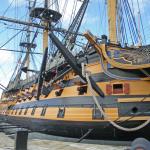HMS Victory, Portsmouth Historic Dockyard
HMS Victory is part of the Portsmouth Historic Dockyard, which is a large site containing a number of ships, museums and other attractions. As such, there is the option to purchase either an all attraction ticket, or a single attraction ticket, both of which last for a year. A single adult ticket for HMS Victory costs £18, and children cost £13; but a ticket covering all of the attractions costs £32 and £23 respectively (there is a discount for buying online as well).
A single adult ticket for HMS Victory costs £18, and children cost £13; but a ticket covering all of the attractions costs £32 and £23 respectively (there is a discount for buying online as well).
HMS Victory was Nelson’s flagship, on which he fought, and died, in the Battle of Trafalgar. As such, it is of massive historical importance, unlike many other ships that are open to the public. Not only has this warship seen battle, but it led the strategy for the whole fleet in the most decisive sea battle of the Napoleonic WarsThe Napoleonic Wars lasted from 1803 until 1815 (although some people also include the French Revolutionary Wars in this, which started in 1792 and continued until 1802. The Napoleonic Wars were therefore a continuation of the Revolutionary Wars). A number of European powers fought against the expansionist French Empire.. During the Battle of Trafalgar the Franco-Spanish fleet lost 22 ships, to none of Britain’s, and some have argued this victory confirmed the UK’s supremacyThe state of being superior to all others in authority, power, or status of the seas. On board the ship, it is still possible to see where Nelson fell, hit in the shoulder with shot that pierced his lungs and lodged in his spine. This brilliant, inspiring and unusual naval tactician requested to be taken below to the orlop deck so his men wouldn’t see him, and he died three hours after being injured.
The ship, although undergoing continuing restoration and now missing the top two thirds of her masts, is on view as close to how she would have looked at the Battle as possible. The route around the ship is structured (unlike so many others we have visited, which tend to be more free-flowing) with signs pointing the way and ropes keeping visitors away from certain areas. Whilst this wouldn’t be the ideal way, for me at least, to view HMS Victory, it does help to manage the large number of visitors throughout the day (something which is also helped by queuing and boarding arrangements). The gun decks are laid out with cannon, weaponry and the day-to-day items essential for the full complement of 837 men to live. The majority of Nelson’s quarters, and all of Hardy’s, are sadly roped off from the general public which, while understandable, is disappointing. Many of the petty officers’ and specialists’ areas are on view, and there are some signs, printed information and guides (some of whom are in character) along the way.
However, more information about the different aspects of the ship would have been useful – if you don’t know naval history, I’m not sure how much you would learn simply by walking round HMS Victory. There is also the option of taking guided tours, although this is something we as a family chose not to do because of the age of our children. Unfortunately, with the exception of the staff in character, there was little to engage younger children and I think ours began to get bored quite quickly. This wasn’t helped by the number of people walking round, despite the efforts of crowd control, and is something to bear in mind when visiting: like the Colosseum, if you want to avoid crowds, go at the very beginning or end of the day. There is, of course, a further point that needs to be made: access is severely restricted. HMS Victory is an eighteenth century warship, and as such was not designed for pushchairs or wheelchairs. Those with mobility issues will not be able to enjoy it.
All of this being said, the very presence of the ship, as well as its atmosphere and story, make this a remarkable attraction and one not to be missed for those interested in the sea or in the history of the Napoleonic Wars.
For more information about HMS Victory, click here.
- Log in to post comments







